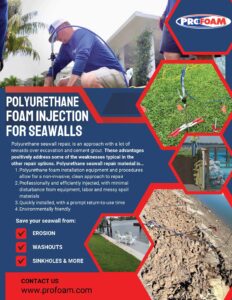Why Are Polyurethane Foam Injections The Right Choice For Your Sea Wall Repair?
Foam Injections For Sea Wall Repair Across South Carolina
Warning Signs You May Need To Repair Your Sea Wall
- Soil is caving in around and behind your seawall
- Noticeable cavities and voids are forming, and larger sinkholes may appear.
- Adjoining concrete walkways, sidewalks, patio or pool deck slabs have settled and are cracking.
- Concrete retaining walls have vertical and horizontal cracks
Seawall foam repair is completed using a single component polyurethane system. This polyurethane is ideal because it permeates the soil and compromised areas of the seawall in liquid form and then reacts and expands to stabilize the soils and to seal the cracks. The polyurethane is light-weight and but is also devoid of compressive strength, so while it strengthens soils by forming them into a polyurethane soil composite, it doesn’t have the risk of blowing out your seawall like other polyurethane systems.
Negatives Of Cement and Concrete Gouting
Traditional methods for installing supplemental concrete tie backs and repairing seawall seams involves negatively affecting yards, landscaping, docks and pool areas.
- Concrete grout substantially increases the pressure and weight behind the seawall structure, which risks the wall cracking or failing.
- Cement grouting entails a significant amount of equipment and labor, which creates a negative impact on your property.
- Contraction and shrinking is also problematic expressly related to cement grouting.
Benefits of Polyurethane Foam Injections
1. Polyurethane foam installation equipment and procedures allow for a non-invasive, clean approach to repair
2. Professionally and efficiently injected, with minimal disturbance from equipment, labor and messy spoil materials
3. Quickly installed, with a prompt return-to-use time
4. Environmentally Friendly
Click The Links Below to Download FREE Sea Wall Repair Guides:
5e65586d3cd82fa9d2f2a2718f317213c3339bc7
89d627f600c51754c91214a8f485cde6bcdd13b6


